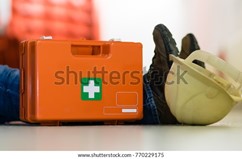When it comes to construction, it is important you know how to respond in emergency situations. The industry as you have come to learn, is regarded as dangerous therefore knowing the who and what with regards to emergencies becomes an integral part of your career. There are different types of emergencies within construction, some of these include the serious injury of a worker, (for example falling from heights, into a trench, an object falling) hitting a gas pipe which presents risk of explosion, fires, electrocution, injury from tools and the list continues.
Depending on the organisation, some or all team members may be required to partake in basic first aid and CPR training.
The regulatory authority in your state or territory has requirements for an emergency contact to be clearly identified on each work site. Usually, this is a poster, sign or board attached to the fence surrounding the work site. It is also likely that there is an emergency response poster which is in a prominent position on site.
Your workplace’s emergency management policies and procedures will also have emergency contact points.
Many work sites will have an emergency response poster. Emergency plans must be developed within accordance with the work that is being carried out and stipulate what to do in the event of an emergency on the site or premises.
The poster will include:
- emergency contact details for the main contractor
- details for local medical centres and hospitals
- exit points
- assembly points.
Emergency information can also be found in the site’s emergency response plan and in the workplace’s policies and procedures.

There are a series of steps that need to be carried out if you are faced with an emergency.
- Follow your organisation’s/work site’s emergency plan.
- Remain calm.
- Call emergency services or get someone else to raise the alarm and inform the site supervisor.
- Assess the area, obtain situational awareness and identify what they can do to eliminate or control the situation (where safe to do so).
- Provide first aid if you are able to do so (that is, if it is safe and within your own capability), otherwise keep the person/s safe and comfortable until emergency services arrive. If you do provide first aid, keep notes of the treatment that you provide and report the details to the person designated in your workplace’s policy and procedures as soon as possible.
- Barricade the area or put up signage, take action to use firefighting equipment if appropriate and safe to do so, apply shut down procedures.
- Ensure the area is protected and preserved for investigative purposes. Do not remove anything, move anything, etc.
- Complete incident reports.

